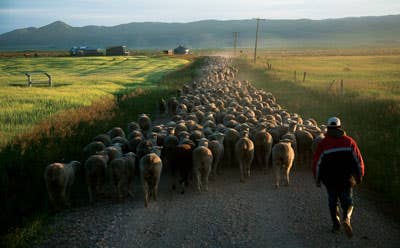
A Shepherd’s Life
Henry Etcheverry is one of the last of Idaho's Basque sheep ranchers. His forebears settled here—in a terrain not so different from the Basques' native Pyrenees—after emigrating from France and Spain in the 19th and 20th centuries. Deep in the state's Caribou National Forest, in fact, you can still find aspen trees with the name of Etcheverry's father, Jean Pierre Etcheverry, carved into them—enduring signposts from a dwindling Basque diaspora. The way these Basque-descended farmers tend their flocks looks almost quaint in this age of industrial agriculture, but their methods are in fact characteristic of how most American lamb is raised. Some 7 million sheep are born each year in the United States, and they spend most of their existence in settings as natural and bucolic as the 500,000 acres where Etcheverry's lambs graze.
Every morning during the late spring and summer, Henry Etcheverry, a solidly built, straight-talking 60-year-old, drives his pickup truck from his home in the town of Lava Hot Springs into the nearby mountains to take supplies to his crew of 12 herders, who live at simple campsites while they move Etcheverry's 16,000 head of sheep across the range. To accompany Etcheverry on one of these trips is to see sheepherding much as it has been done for centuries. On one such excursion last July, Etcheverry stopped his truck on a dirt road to talk with Romulo Inga, a Peruvian herder who is responsible for about 2,300 of Etcheverry's sheep. In Spanish they discussed how much rice and cooking oil Inga would need for the coming days and where Inga, who herds on horseback, would set up camp the next day. As the two men talked, Inga's sheep advanced down a steep, grassy mountainside, breakfasting on anise, sage, wild parsley, larkspur, and other wild herbs and grasses, which filled the air with their aromas.
"A lamb is like a peach," Etcheverry said, pointing to a particularly broad-shouldered animal with a speckled face and tight, rippled wool. "You have to pick it at the right moment." This lamb, like thousands of others pastured here, was born in January and was moved with its mother to these high-country rangelands in May. Sometime in August, when the lamb would reach at least 125 pounds—the weight Etcheverry has determined to be ideal for attaining the right ratio of muscle to fat—it would be trucked to Colorado, where the animal would be finished on corn and other feed before being slaughtered and sold.
A few days later Etcheverry and his wife, Kathy, drove to the home of another Basque sheep rancher, Jean Leon Jauregui, for dinner. Jauregui's wife, Josie, had prepared a meal of lamb chops grilled over aspen coals with white beans and leek soup. At the end of the supper, over plates of flaky cherry tart and glasses of a Basque liqueur made with sloe berries and anise, the men talked about the past, about Etcheverry's father, Jean Pierre, who'd worked on the range until his final years. "We sheep men retire when our arms are folded and we're in a box," Etcheverry said.
Then Jauregui raised a toast. "Your dad was the best man that God made," he said.
Keep Reading
Continue to Next Story










